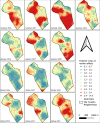Association between densities of adult and immature stages of Aedes aegypti mosquitoes in space and time: implications for vector surveillance
- PMID: 35440010
- PMCID: PMC9020056
- DOI: 10.1186/s13071-022-05244-4
Association between densities of adult and immature stages of Aedes aegypti mosquitoes in space and time: implications for vector surveillance
Abstract
Background: Mosquito control is currently the main tool available to contain the spread of several arboviruses in Brazil. We have evaluated the association between entomological surveys of female adult Aedes aegypti and the Breteau index (BI) in space and time in a hyperendemic area, and compared the human resources costs required to measure each of these indicators.
Methods: Entomological surveys were conducted between 2016 and 2019 in Vila Toninho, a neighborhood in the city of São José do Rio Preto, Brazil. Monthly records of collected mosquito specimens were made and then grouped by season.
Results: Our findings showed that adult and immature mosquitoes are more related in time than in space, possibly due to differences in their habitats or in climate variables. Bayesian temporal modeling revealed that an increase in 1 standard deviation in the BI was associated with a 27% increase in the number of adult female mosquitoes when adjusted for climatic conditions. The cost of entomological surveys of adult mosquitoes was found to be 83% lower than the cost of determining the BI when covering the same geographic area.
Conclusions: For fine-scale assessments, a simple measure of adult Ae. aegypti abundance may be more realistic than aquatic indicators, but the adult indices are not necessarily the only reliable measure. Surveying adult female mosquitoes has significant potential for optimizing vector control strategies because, unlike the BI, this tool provides an effective indicator for micro-areas within an urban region. It should be noted that the results of the present study may be due to specific features of of the study area, and future studies should analyze whether the patterns found in the study neighborhood are also found in other regions.
Keywords: Bayesian analysis; Breteau index; Entomological index; Mosquito.
© 2022. The Author(s).
Conflict of interest statement
The authors declare that they have no known competing financial interests or personal relationships that could have appeared to influence the work reported in this paper.
Figures




References
-
- Service MW Importance of ecology in Aedes aegypti control. Southeast Asian J Trop Med. 1992;23:681–690. - PubMed
MeSH terms
Grants and funding
LinkOut - more resources
Full Text Sources
Medical

